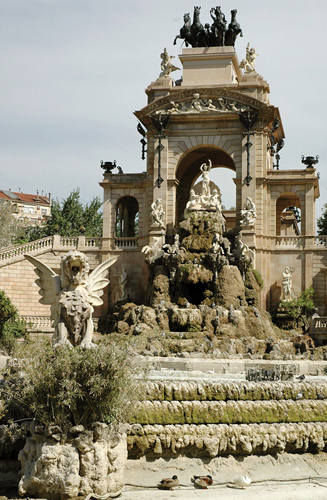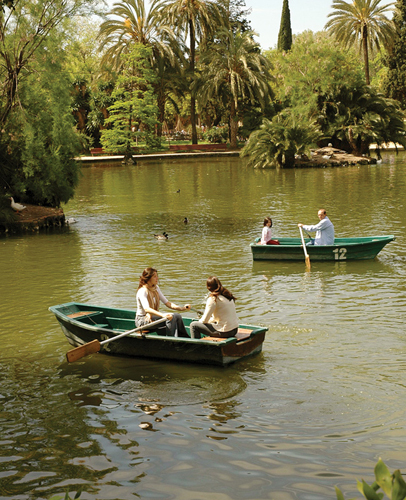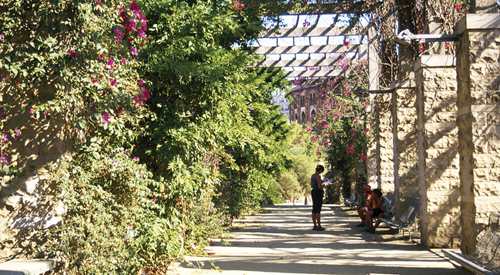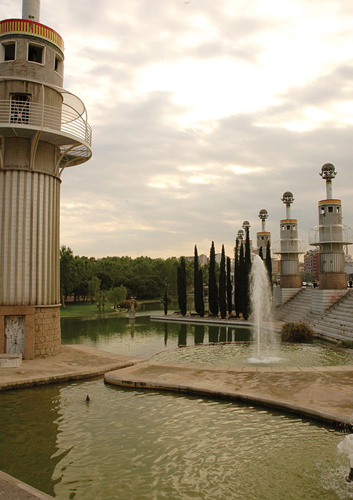|
All the city parks are officially open from around 10am until dusk.
|
|
Parc de la Ciutadella Barcelona’s
largest landscaped park offers a serene antidote to city life. Once the
location of the 18th-century military citadel, this lovely 19th-century
park is now home to the zoo, the Catalan parliament, two museums and a
boating lake. There is an attractive outdoor café next to the Castell
dels Tres Dragons (in the south-western corner).

Cascade Fountain, Parc de la Ciutadella

Parc Güell Originally
conceived as a suburban estate to the north of the city, Parc Güell is
like a surreal, Asian terraced farm. Twisting pathways and avenues of
columned arches blend in with the hillside, playfully fusing nature and
fantasy. The esplanade, with its stunning, curved, mosaic bench, is the
park’s centrepiece. From here there are spectacular views of the entire city and of the fairy-tale gatehouses below. Gaudí’s former home is now the Casa-Museu Gaudí. Jardins del Laberint d’Horta These
enchanting Neo-Classical gardens date back to 1791, making this elegant
park one of the oldest in the city. Situated up above the city, where
the air is cooler and cleaner, the park includes themed gardens,
waterfalls and a small canal. The highlight is the enormous maze, which
has a statue of Eros at its centre. Parc de Cervantes Built
in 1964 to celebrate 25 years of Franco rule, this beautiful park on
the outskirts of town would have been more appropriately named Park of
the Roses. There are over 11,000 rose bushes of 245 varieties; when in
bloom, their aroma pervades the park. People pour in at weekends, but
the park is blissfully deserted during the week. Jardins de Pedralbes These picturesque gardens lie just in front of the former Palau Reial (royal palace) of Pedralbes
– now home to the Museu de Ceràmica and Museu de les Arts Decoratives.
Under the shade of an enormous eucalyptus tree and near a small bamboo
forest is a fountain by Gaudí, which was only discovered in 1983. Parc de Joan Miró Also know as Parc de l’Escorxador, this park was built on the site of a 19th-century slaughterhouse (excorxador). Dominating the paved upper level of the park is Miró’s striking 22-m (72-ft) sculpture, Dona i Ocell (Woman and Bird; 1983). Elsewhere there are three children’s play areas set around a café.

Parc de Joan Miró
Parc de l’Espanya Industrial Built
on the site of a former textiles factory, this modern park, by Basque
architect Luis Peña Ganchegui, has deteriorated somewhat since its
inauguration in 1985. It still has a certain appeal, including ten
strange lighthouse-style towers that line the boating lake and an
enormous cast-iron dragon, which doubles as a slide. There’s a good
terrace bar with a playground for the kids.

Parc de l’Espanya Industrial
City Beaches The
beaches of Barcelona were once insalubrious areas to be avoided. With
the 1992 Olympics they underwent a radical face-lift and today the
stretches of Barceloneta and the Port Olímpic are a major people magnet.
Just a short hop on the metro from the city centre, they provide the
perfect opportunity for a refreshing Mediterranean dip. The beaches are
regularly cleaned and the many facilities include showers, toilets,
children’s’ play areas, volleyball nets and an open-air gym. There are
boats and surfboards for rent. Be warned: bag snatching is endemic.

Barceloneta beach
Castelldefels Just
20 km (12 miles) south of Barcelona are 5 km (3 miles) of wide, sandy
beaches with shallow waters. Beach bars entice weekend sun worshippers
out of the afternoon sun for long, lazy seafood lunches and jugs of
sangria aplenty. Windsurfers and pedalos are for hire. Premià/El Masnou By
far the best beaches within easy reach of Barcelona, just 20 km (12
miles) to the north, these two adjoining beaches lure locals with
gorgeous golden sand and clear, blue waters.
|